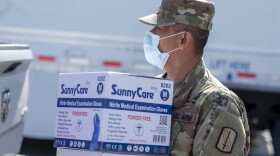Three women wearing white lab coats, masks, face shields and gloves stood around a table on a recent afternoon at LabCorp's Burlington headquarters, using box cutters to open packages. Inside each package was a box containing a plastic sample tube.
These are the company’s at-home coronavirus test kits. They’re among the tens of thousands of coronavirus test swabs from across the U.S. that the North Carolina lab location receives daily.

“For the surrounding states, those use our driver fleet or we have airplanes that bring in specimens in the overnight hours,” said Dr. Mindy Nye, a vice president at LabCorp. “Then we use commercial airlines throughout the day to get us things from the West Coast.”LabCorp has processed about 14 million coronavirus tests since it began on March 5. The Burlington location has the highest volume out of the company’s 20 labs nationwide with as many as 320 workers processing tests, according to a LabCorp spokesperson.
“Twenty-four hours a day, seven days a week. There’s no part of the process that only happens once a day. It’s a continual flow,” said Nye.
In addition to at-home kits, the labs collect swabs from doctor’s offices, hospitals and test sites like CVS and Walgreens. Combined, they can process about 200,000 tests per day.
What Happens To Your Swab
When a coronavirus swab arrives at the Burlington lab, it’s put into a rack with 91 other specimens. Then it goes to a special section on the lab’s second floor, where LabCorp technicians use a pipette — like a giant eyedropper — to pull out the liquid from around the swab.

“We don’t test the swab, we test the media that the swab’s been sitting in,” Nye said.
Technicians transfer the liquid to what’s called a plate. It looks like a tiny egg carton with wells for each patient specimen. Next, lab workers use heat or a chemical to kill the virus.
“We’re taking that primary specimen and really killing the virus and concentrating it so that if there's a target there we can detect it at the molecular level,” Nye said.
A machine concentrates the specimen, or washes away any unnecessary junk that might have been up your nose when the test was taken. The specimens are then moved to a different plate with 384 wells. Your swab and hundreds of other swabs — in individual chambers on the plate — are mixed with a chemical that helps detect the coronavirus.

Finally, a machine tests the specimens and looks for the virus’ genetic material. This last step takes about one hour and 10 minutes, according to Nye. Each batch of samples tested has at least one positive and one negative sample, called controls, so technicians can ensure that all of the test steps are working properly.The Business Of Testing
LabCorp has gained a lot of business with coronavirus testing. The company added 23% to its business volume in June, according to its quarterly report.
But it’s lost some business, too.
“We have over 5,000 tests on our menu, and the COVID testing is only a couple of the tests out of the 5,000,” said Brian Caveney, LabCorp’s chief medical officer and president of diagnostics.
When doctor’s offices and hospitals reduced their patent volumes in the spring because of the pandemic, health care workers were ordering fewer tests.
“Colorectal cancer screenings, women getting pap smears. A lot of those standard medical tests have gone down significantly,” Caveney said.
According to its quarterly reports, LabCorp lost about $88 million in revenue between January and June compared to the same period in 2019. The company also received about $56 million via the coronavirus-relief CARES Act.
Caveney said LabCorp has pivoted a lot of its scientists and technicians to help with coronavirus testing and continues to hire more people. The Burlington lab location currently has about 200 open positions.
for the latest coronavirus news on WFAE’s live blog.
for The Frequency, WFAE’s daily email newsletter.
What questions do you have about the coronavirus? What has this experience been like for you? Share your questions below._
Copyright 2021 WFAE. To see more, visit . 9(MDAxNzg0MDExMDEyMTYyMjc1MDE3NGVmMw004))









